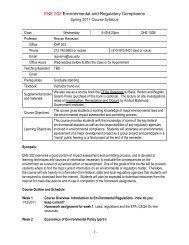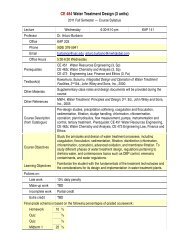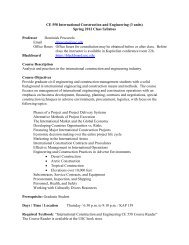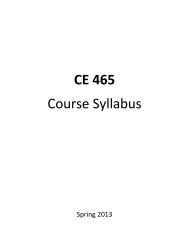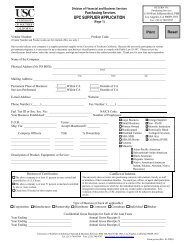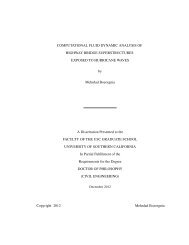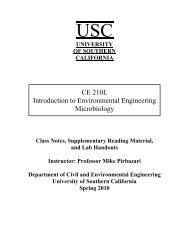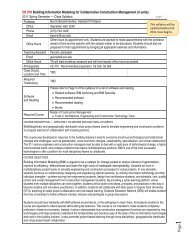ENE 486 Course Syllabus - Civil and Environmental Engineering
ENE 486 Course Syllabus - Civil and Environmental Engineering
ENE 486 Course Syllabus - Civil and Environmental Engineering
You also want an ePaper? Increase the reach of your titles
YUMPU automatically turns print PDFs into web optimized ePapers that Google loves.
<strong>ENE</strong> <strong>486</strong><br />
<strong>Course</strong> <strong>Syllabus</strong><br />
Fall 2012
Part I <strong>Course</strong> Organization
<strong>ENE</strong> <strong>486</strong> Design of Hazardous & Solid Wastes <strong>Engineering</strong> System<br />
Fall 2012 <strong>Course</strong> <strong>Syllabus</strong><br />
Class Thursday 6:30-9:10pm KAP 137<br />
Professor Rezvan Ramezani<br />
Office<br />
Phone (909) 396-2701 Work — (310) 932-8341 Cell<br />
Email rezvanra@usc.edu<br />
Office Hours Thursday 5:30-6:30 or by Appointment<br />
Teaching Assistant<br />
Email<br />
Prerequisites <strong>ENE</strong> 400 (<strong>Environmental</strong> <strong>Engineering</strong> Principles)<br />
Textbooks<br />
<strong>Course</strong> Objectives<br />
Learning Objectives<br />
Synopsis:<br />
1. HAZARDOUS WASTES: Sources Pathways Receptors<br />
by Richard J. WATTS<br />
ISBN: 9780471002383<br />
Additional Supplemental material on weekly basis<br />
This course is designed to provide students with the necessary<br />
background <strong>and</strong> knowledge pertaining to the engineering design of<br />
solid <strong>and</strong> hazardous waste facilities.<br />
The course consists of three major components. The first component of<br />
the class includes three main parts which are devoted to the following: (1)<br />
the description of waste generation, effects of improper management, <strong>and</strong><br />
management options, (2) related legislation <strong>and</strong> regulations for facility<br />
design, <strong>and</strong> design criteria, <strong>and</strong> (3) future trends in waste management.<br />
The second component is devoted to solid waste engineering, consisting<br />
of engineering principles <strong>and</strong> actual design cases for major solid waste<br />
management facilities, such as transfer stations, sanitary l<strong>and</strong>fills,<br />
incinerators, material <strong>and</strong> energy facilities, etc. The third component will<br />
be devoted to hazardous engineering, covering related engineering<br />
principles <strong>and</strong> actual design cases for major hazardous management<br />
facilities, such as waste minimization, secured l<strong>and</strong>fills, thermal, chemical,<br />
physical, <strong>and</strong> biological treatment facilities, site remediation facilities, <strong>and</strong><br />
radioactive waste treatment/remediation facilities, etc.<br />
In <strong>ENE</strong> 4846, the course realizes that owing to the fact that there are wide varieties of solid <strong>and</strong><br />
hazardous waste management facilities available; therefore, the course will focus on major<br />
facilities which are widely used currently, <strong>and</strong> give a general discussions on other relatively less<br />
practiced technologies. Type of facilities will include treatment, storage <strong>and</strong> disposal facilities for<br />
both solid <strong>and</strong> hazardous wastes. For hazardous waste engineering, the “uncontrolled<br />
hazardous waste site” remediation facilities will be also included. For major facilities, the<br />
theories, parameters, <strong>and</strong> procedures associated with the design will be presented in detail.<br />
- 1 -
<strong>ENE</strong> <strong>486</strong> Design of Hazardous & Solid Wastes <strong>Engineering</strong> System<br />
Fall 2012 <strong>Course</strong> <strong>Syllabus</strong><br />
Field trips <strong>and</strong> evaluation of actual design cases will be provided so students can gain practical<br />
knowledge on the subject.<br />
<strong>Course</strong> Outline <strong>and</strong> Schedule<br />
PART I. INTRODUCTION<br />
Week (8-30-12)<br />
1. Introduction<br />
� <strong>Syllabus</strong> review<br />
� Use of Black Board (BB)<br />
� Statement on Academic Integrity<br />
� Waste Definition, Generation, Effects, Management Options <strong>and</strong> Future<br />
Trends(1.5 week)<br />
i. General <strong>and</strong> legal definitions<br />
ii. Waste Compositions <strong>and</strong> classifications<br />
iii. Waste generation<br />
iv. Effects of in-proper management<br />
v. Management options<br />
vi. Future Trends<br />
Week (9-6-12)<br />
2. General Siting <strong>and</strong> Design Criteria (1.5 week)<br />
� RCRA-C <strong>and</strong> D siting <strong>and</strong> design requirements<br />
� CERCLA/SARA siting <strong>and</strong> design requirements<br />
� Other federal <strong>and</strong> state legislation <strong>and</strong> regulation siting <strong>and</strong> design<br />
requirements<br />
� Summary: Siting criteria<br />
� Summary: Design criteria<br />
PART II. SOLID WASTE ENGINEERING<br />
Week (9-13-12)<br />
3. Principles <strong>and</strong> Design of Transfer <strong>and</strong> Transport Facilities (1/2 week)<br />
� Objective of transfer stations<br />
� Types, siting <strong>and</strong> design criteria of transfer stations<br />
� Design cases<br />
Week (9-20-12)<br />
4. Principles <strong>and</strong> Design of Sanitary L<strong>and</strong>fills (2 weeks)<br />
� L<strong>and</strong>filling methods<br />
� Design goals, basis, <strong>and</strong> variables<br />
� Design of l<strong>and</strong>fill cover <strong>and</strong> drainage/liner systems<br />
� Design of l<strong>and</strong>fill gas migration control <strong>and</strong> recovery systems<br />
- 2 -
<strong>ENE</strong> <strong>486</strong> Design of Hazardous & Solid Wastes <strong>Engineering</strong> System<br />
Week (9-27-12)<br />
Fall 2012 <strong>Course</strong> <strong>Syllabus</strong><br />
� Design of leachate control <strong>and</strong> treatment systems<br />
� Other design variables<br />
� Design cases<br />
5. Principles <strong>and</strong> Design of Material Recovery Facilities (1 week)<br />
� Types <strong>and</strong> objectives of material recovery systems<br />
� Principles, functions, equipment selection <strong>and</strong> comparisons, design criteria,<br />
<strong>and</strong> operation of different material recycling processes<br />
� Integrated <strong>and</strong> specific recycling plants<br />
� Design cases<br />
Week (10-4-12)<br />
6. Principles <strong>and</strong> Design of Energy Recovery Facilities (1 week)<br />
� Types <strong>and</strong> principles of energy conversion processes<br />
� Incinerator design<br />
� Design of other thermal energy conversion systems<br />
� Design cases<br />
PART III. HAZARDOUS WASTE ENGINEERING<br />
Week (10-11-12)<br />
7. Principles <strong>and</strong> Design of Waste Minimization Facilities (1 week)<br />
� Principles <strong>and</strong> techniques of Waste minimization<br />
� Examples of waste types <strong>and</strong> phase separation processes<br />
� Design criteria <strong>and</strong> examples<br />
Week (10-14-10)<br />
8. Principles <strong>and</strong> Design of Hazardous Waste L<strong>and</strong>fills (1 week)<br />
� Design configurations <strong>and</strong> site selection<br />
� Design of final cover, intermediate cover <strong>and</strong> drain/liner systems<br />
� Design of gas <strong>and</strong> leachate control <strong>and</strong> treatment systems<br />
� Design cases<br />
Week (10-18-12)<br />
9. Principles <strong>and</strong> Design of Hazardous Waste Storage Facilities (1/2 week)<br />
� Types <strong>and</strong> design criteria<br />
� selection <strong>and</strong> design of storage facilities<br />
� Design of containment, run-on/run-off management systems<br />
� Design examples<br />
�<br />
- 3 -
<strong>ENE</strong> <strong>486</strong> Design of Hazardous & Solid Wastes <strong>Engineering</strong> System<br />
Week (10-25-12)<br />
Fall 2012 <strong>Course</strong> <strong>Syllabus</strong><br />
10. Principles <strong>and</strong> Design of Thermal Treatment Facilities (1 week)<br />
� Status, types, principles, equipment used, application ranges, <strong>and</strong><br />
comparisons of different thermal treatment technologies<br />
� Design of incinerators<br />
� Design of other thermal systems<br />
� Design cases<br />
Week (11-1-12)<br />
11. Principles <strong>and</strong> Design of Chemical/Physical/Biological Treatment Facilities (1<br />
week)<br />
� Status, types, principles, equipment used, application ranges, <strong>and</strong><br />
comparisons of different treatment facilities<br />
� General design criteria <strong>and</strong> special requirements<br />
� Design cases<br />
Week (11-8-12)<br />
12. Principles <strong>and</strong> Design of Site remediation Facilities (1 week)<br />
� Status, types, principles, equipment used, application ranges, <strong>and</strong><br />
comparisons of different site remediation technologies<br />
� Remedial investigations <strong>and</strong> feasibility studies<br />
� Soil remediation design examples<br />
� Groundwater remediation design examples<br />
Week (11-15-12)<br />
13. Principles <strong>and</strong> Design of Radioactive Waste Treatment/Site Remediation<br />
Facilities (1 week)<br />
� Status, Types, technologies, principles, applications<br />
� Treatment Technologies<br />
� Site Remediation Technologies<br />
� Case Examples<br />
Week (11-22-12) Presentations/Field Trip<br />
Week (11-29-12) Thanksgiving Holiday<br />
Week (12- 6 through 16-10) Finals<br />
- 4 -
<strong>ENE</strong> <strong>486</strong> Design of Hazardous & Solid Wastes <strong>Engineering</strong> System<br />
TERM PROJECTS<br />
FINAL EXAM<br />
Fall 2012 <strong>Course</strong> <strong>Syllabus</strong><br />
Final Exam: Thursday, December 6, 6:30 – 9:00 PM<br />
Term Project should be around 10 pages <strong>and</strong> contain at least 5 references <strong>and</strong> are due on<br />
November 18, 2012. The subject of report should be approved by Lecturer. Each student should<br />
present his/her report in the class (5 minutes per member presentation). More on that as the time<br />
gets close.<br />
GRADING CRITERIA<br />
Item % of Final Grade<br />
Class Participation 10%<br />
Homework 20%<br />
Midterm Exam 20%<br />
Final Exam 20%<br />
Term Projects 30%<br />
Statement for Students with Disabilities<br />
Any student requesting academic accommodations based on a disability is required to register<br />
with Disability Services <strong>and</strong> Programs (DSP) each semester. A letter of verification for approved<br />
accommodations can be obtained from DSP. Please be sure the letter is delivered to me (or to<br />
TA) as early in the semester as possible. DSP is located in STU 301 <strong>and</strong> is open 8:30 a.m.–5:00<br />
p.m., Monday through Friday. The phone number for DSP is (213) 740-0776.<br />
Statement on Academic Integrity<br />
USC seeks to maintain an optimal learning environment. General principles of academic honesty<br />
include the concept of respect for the intellectual property of others, the expectation that<br />
individual work will be submitted unless otherwise allowed by an instructor, <strong>and</strong> the obligations<br />
both to protect one’s own academic work from misuse by others as well as to avoid using<br />
another’s work as one’s own. All students are expected to underst<strong>and</strong> <strong>and</strong> abide by these<br />
principles. Scampus, the Student Guidebook, contains the Student Conduct Code in Section<br />
11.00, while the recommended sanctions are located in Appendix A:<br />
http://www.usc.edu/dept/publications/SCAMPUS/gov/. Students will be referred to the Office of<br />
Student Judicial Affairs <strong>and</strong> Community St<strong>and</strong>ards for further review, should there be any<br />
suspicion of academic dishonesty. The Review process can be found at:<br />
http://www.usc.edu/student-affairs/SJACS/.<br />
- 5 -
<strong>ENE</strong> <strong>486</strong> Design of Hazardous & Solid Wastes <strong>Engineering</strong> System<br />
REFERENCES<br />
Fall 2012 <strong>Course</strong> <strong>Syllabus</strong><br />
1. Legislation: RCRA, CERCLA/SARA <strong>and</strong> California State related legislation (current<br />
issues).<br />
2. Related Code of Federal Regulations <strong>and</strong> California Code of Regulations (current issues).<br />
3. Kreith, F. (Editor in Chief), H<strong>and</strong>book of Solid Waste Management, McGraw-Hill, Inc.<br />
(1994).<br />
4. Tchobanoglous, G., Theisen, H., <strong>and</strong> Eliassen, R., Solid Wastes <strong>Engineering</strong> Principles<br />
<strong>and</strong> Management Issues, McGraw-Hill, Inc. (1993).<br />
5. Theodore, L., Reynolds, J. P., Introduction to Hazardous Incineration, John Wiley & Son<br />
(1987).<br />
6. Freeman, H. M., St<strong>and</strong>ard H<strong>and</strong>book of Hazardous Waste Treatment <strong>and</strong> Disposal,<br />
McGraw-Hill, Inc. (1997).<br />
7. Wentz, C. A., Hazardous Waste Management, McGraw-Hill, Inc. (1995).<br />
8. Rossiter, A. P. (Editor), Waste Minimization Through Process Design, McGraw-Hill, Inc.<br />
(1995).<br />
9. Wong, J., Nolan, G. L., Design of Remediation Systems, Lewis Publishers, Inc. (1997).<br />
10. Berlin, R. E., Stanton, C. C., Radioactive Waste Management, John Wiley & Sons<br />
(1989).<br />
11. Devinny, J. S., Everett, L. G., Lu, J. C., Stollar, R. L., Subsurface Migration of<br />
Hazardous Wastes (1990).<br />
12. Lu, J. C., et. al., Production <strong>and</strong> Management of Leachate from Municipal L<strong>and</strong>fills:<br />
Summary <strong>and</strong> Assessment.<br />
13. Design cases (to be provided in the class).<br />
- 6 -
Part II Detailed <strong>Course</strong><br />
Objectives
<strong>ENE</strong> <strong>486</strong><br />
Design of Solid <strong>and</strong> Hazardous Waste <strong>Engineering</strong> Systems 3 Units<br />
USC | SONNY ASTANI DEPARTMENT OF CIVIL AND ENVIRONMENTAL ENGINEERING<br />
ABET <strong>Course</strong> <strong>Syllabus</strong><br />
<strong>Course</strong> Information, Textbook, <strong>and</strong> Supplementary Materials Design Kernel<br />
<strong>Course</strong> Description: <strong>Engineering</strong> design of solid <strong>and</strong> hazardous waste facilities such as<br />
waste minimization, secured l<strong>and</strong>fill, <strong>and</strong> hazardous waste treatment.<br />
Design Kernel for: <strong>ENE</strong> <strong>Environmental</strong> Required for: BS<strong>ENE</strong><br />
Prerequisites: <strong>ENE</strong> 400 <strong>Environmental</strong> <strong>Engineering</strong> Principles <strong>and</strong> CE 473 <strong>Engineering</strong> Law, Finance <strong>and</strong> Ethics<br />
Co-Requisite: None<br />
Required Textbooks:<br />
1. Bagchi, A., Design of L<strong>and</strong>fills <strong>and</strong> Integrated Solid Waste Management, Wiley Publishing Co., 3 rd Edition (2004).<br />
2. Wong, J., Hong, C., Nolan, G., Design of Remediation Systems, CRC Press (19970.<br />
3. Lu, J., Solid <strong>and</strong> Hazardous Wastes <strong>Engineering</strong>, CD-Rom H<strong>and</strong>outs (2005).<br />
References:<br />
1. Legislation: RCRA, CERCLA/SARA <strong>and</strong> California State<br />
related legislation (current issues).<br />
2. Related Code of Federal Regulations <strong>and</strong> California Code<br />
of Regulations (current issues).<br />
3. Kreith, F. (Editor in Chief), H<strong>and</strong>book of Solid Waste<br />
Management, McGraw-Hill, New York (1994).<br />
4. Tchobanoglous, O., Theisen, H., <strong>and</strong> Eliassen, R., Solid<br />
Wastes <strong>Engineering</strong> Principles <strong>and</strong> Management Issues,<br />
McGraw-Hill, New York (1993).<br />
5. Theodore, L., Reynolds, J. P., Introduction to Hazardous<br />
Incineration, John Wiley, New York (1987).<br />
Topics Covered Learning Outcomes<br />
Introduction to engineering<br />
design of solid <strong>and</strong> hazardous<br />
waste facilities<br />
6. Freeman, H. M., St<strong>and</strong>ard H<strong>and</strong>book of Hazardous Waste<br />
Treatment <strong>and</strong> Disposal, McGraw-Hill, New York (1997).<br />
7. Wentz, C. A., Hazardous Waste Management, McGraw-<br />
Hill, Inc. (1995).<br />
8. Rossiter, A. P. (Editor), Waste Minimization Through<br />
Process Design, McGraw-Hill, New York (1995).<br />
9. Wong, J., Nolan, 0. L., Design of Remediation Systems,<br />
Lewis Publishers, Boca Raton, Florida (1997).<br />
10. Berlin, R. E., Stanton, C. C., Radioactive Waste<br />
Management, John Wiley, New York (1989).<br />
11. Design cases (provided in the class).<br />
Students will underst<strong>and</strong> the components of solid <strong>and</strong> hazardous waste; <strong>and</strong> the principles of<br />
design:<br />
1. Waste Definition, Generation, Effects, <strong>and</strong> Management Options<br />
2. Legislation <strong>and</strong> Regulations<br />
3. General Siting <strong>and</strong> Design Criteria<br />
4. Future Trends<br />
Solid Waste <strong>Engineering</strong> 5. Principles <strong>and</strong> Design of Transfer <strong>and</strong> Transport Facilities<br />
6. Principles <strong>and</strong> Design of Sanitary L<strong>and</strong>fills<br />
7. Principles <strong>and</strong> Design of Material Recovery Facilities<br />
8. Types <strong>and</strong> principles of energy conversion processes<br />
9. Principles <strong>and</strong> Design of Waste Minimization Facilities<br />
10. Principles <strong>and</strong> Design of Hazardous Waste L<strong>and</strong>fills<br />
11. Principles <strong>and</strong> Design of Hazardous Waste Storage Facilities<br />
12. Principles <strong>and</strong> Design of Thermal Treatment Facilities<br />
13. Principles <strong>and</strong> Design of Chemical/Physical/Biological Treatment Facilities<br />
14. Principles <strong>and</strong> Design of Site remediation Facilities<br />
15. Principles <strong>and</strong> Design of Radioactive Waste Treatment/Site Remediation Facilities<br />
Page 1
<strong>ENE</strong> <strong>486</strong><br />
Lecture <strong>and</strong> Lab Schedule<br />
Design of Solid <strong>and</strong> Hazardous Waste <strong>Engineering</strong> Systems 3 Units<br />
USC | SONNY ASTANI DEPARTMENT OF CIVIL AND ENVIRONMENTAL ENGINEERING<br />
Lecture Lab<br />
Sessions per Week Duration per Session Sessions per Week Duration per Session<br />
1 3 hours<br />
Contribution of <strong>Course</strong> to Meeting the Professional Component<br />
<strong>Engineering</strong> Topics | Design<br />
Students will underst<strong>and</strong> the design process <strong>and</strong> learn approaches used to solve various engineering problems that are<br />
representative of those found in a professional environment. They will practice decision-making skills as they apply their<br />
knowledge of basic sciences, mathematics, <strong>and</strong> the engineering sciences to convert resources optimally to meet the stated<br />
needs of a project.<br />
This course is designed to provide students with the necessary background <strong>and</strong> knowledge pertaining to the engineering design<br />
of solid <strong>and</strong> hazardous waste facilities. Two field trips give the students the opportunity to tour both a solid <strong>and</strong> hazardous waste<br />
engineering facility.<br />
<strong>Engineering</strong> Topics | Other<br />
Constraints <strong>and</strong> Considerations. Students will underst<strong>and</strong> the diverse constraints <strong>and</strong> considerations that are representative of<br />
what they will encounter in an engineering practice. This course covers the following topics:<br />
Economic | <strong>Environmental</strong> | Sustainability | Ethical | Health <strong>and</strong> Safety | Social | Political | Energy<br />
Relation of <strong>Course</strong><br />
Objectives to Program Outcomes <strong>Course</strong> Contribution to Program Outcomes (a-k)<br />
The <strong>Civil</strong> <strong>Engineering</strong> program is designed<br />
to teach beyond the technical content of the<br />
curriculum <strong>and</strong> prepare the students to<br />
utilize what they learn in a professional<br />
setting.<br />
This course contributes to the program<br />
outcomes as outlined in the adjacent table.<br />
Prepared by: Dr. Rezvan Ramezani<br />
Professor of <strong>Civil</strong> <strong>and</strong> <strong>Environmental</strong> <strong>Engineering</strong><br />
Date: Fall 2012<br />
a. An ability to apply knowledge of mathematics, science, <strong>and</strong><br />
engineering.<br />
c. An ability to design a system component or process to meet desired<br />
needs within realistic constraints such as economic, environmental,<br />
social, political, ethical, health <strong>and</strong> safety, manufacturability, <strong>and</strong><br />
sustainability.<br />
h. The broad education necessary to underst<strong>and</strong> the impact of<br />
engineering solutions in a global economic <strong>and</strong> environmental <strong>and</strong><br />
societal context.<br />
�<br />
Key<br />
�<br />
Page 2


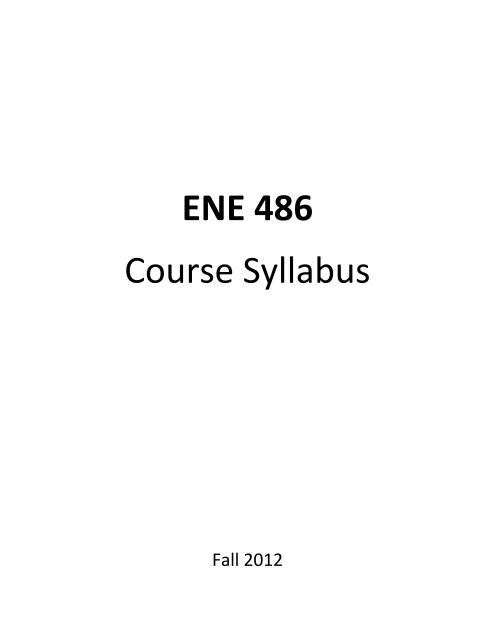

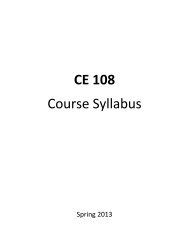
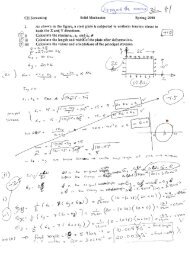
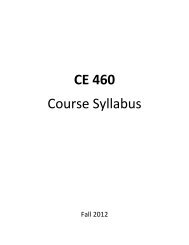
![Dr. Yan Xiao Bamboo Road Bridge can Support 16-Ton[ne] - USC](https://img.yumpu.com/37910641/1/190x245/dr-yan-xiao-bamboo-road-bridge-can-support-16-tonne-usc.jpg?quality=85)
